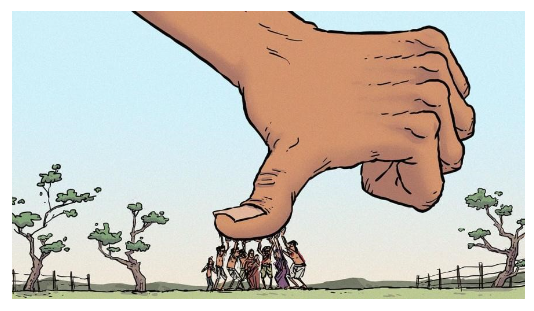Tuesday, 12th December 2023
Italy Withdraws from China’s BRI
In News: After more than four years of being the sole G7 nation to join, Italy has decided to exit China's Belt and Road Initiative.
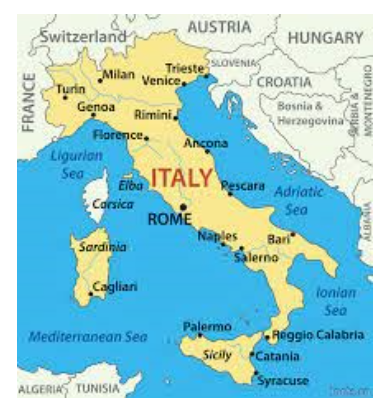
Italy's Departure from China's Belt and Road Initiative: Unravelling Economic and Geopolitical Dynamics
Background
Italy's exit from China's Belt and Road Initiative (BRI) comes more than four years after being the sole G7 nation to sign up, indicating a significant shift in economic, geopolitical, and strategic considerations.
Reasons for Italy’s Withdrawal
- Economic Imbalance: Anticipated economic benefits have not materialized, with Chinese FDI in Italy dropping significantly.
- Geopolitical Realignment: Concerns over China's influence, geopolitical alignments, and global events like the Russia-Ukraine conflict have led Italy to reassess its participation.
- Alignment with Western Allies: Italy's inclination to align with its Western allies, especially in the G7, may influence its decision.
- Negative Press and Debt Concerns: Global criticism of the BRI for potential debt traps and lack of transparency has contributed to Italy's withdrawal.
Implications
Italy's departure reflects a broader trend in European nations reassessing their relationships with China, emphasizing the evolving dynamics in global geopolitics.
Evolution of India-Italy Relations: A Historical Perspective
- Historical and Cultural Ties
- India and Italy boast a rich historical connection dating back millennia, characterized by vibrant trade routes and cultural exchanges.
- Renowned figures like Rabindranath Tagore and Mahatma Gandhi have contributed to the enduring historical tapestry of bilateral relations.
- Challenges in Bilateral Relations
- Italian Marines Case (2012): The tragic incident involving two Italian marines accused of killing Indian fishermen strained diplomatic ties. The prolonged legal and political dispute was resolved in 2021, following compensation from Italy to India.
- AgustaWestland Allegations: Corruption allegations related to the AgustaWestland deal created another hurdle. Despite the cancellation of the contract and legal proceedings, the Italian courts dismissed all charges due to insufficient evidence.
- Rebuilding Relations
- Diplomatic Engagement (2018 onwards): Both nations-initiated efforts to mend relations through official visits, cultural exchanges, and high-level engagements.
- Strategic Partnerships (2021): Significant milestones were achieved during the Indian Prime Minister's visit to Italy for the G20 summit in 2021. Bilateral agreements were established, focusing on defines, trade, and technology.
- Economic Cooperation: Italy emerged as a key trading partner for India within the EU. The emphasis on economic cooperation, especially in defence and technology, has contributed to strengthening bilateral ties.
- Collaboration in Diverse Areas
- Science, Technology, and Research: Thematic Working Groups were established in 2021 between the Italian Space Agency (ASI) and the Indian Space Research Organisation (ISRO), focusing on Helio physics—the study of the Sun's effects on the Solar System.
- Counter-Terrorism and Security: Both nations pledged to strengthen cooperation in combating terrorism and transnational crime, with a joint working group on counter-terrorism advancing expertise exchange and capacity building.
- Regional Cooperation and Connectivity: Acknowledging the potential of international organizations such as the Coalition on Disaster Resilient Infrastructures (CDRI) and the International Solar Alliance (ISA), India welcomed Italy's participation in the ISA after its universalization. The shared commitment to these initiatives’ further cements bilateral cooperation.
Charting the Path Forward: Strengthening India-Italy Relations
- Opportunities for Economic Collaboration
- With Italy's withdrawal from the Belt and Road Initiative (BRI), there exists an opportune moment for India and Italy to diversify their economic collaboration. Both nations can explore new avenues for trade, investment, and joint ventures.
- Prioritizing sectors like technology, manufacturing, renewable energy, pharmaceuticals, and infrastructure development can pave the way for mutually beneficial partnerships.
- Leveraging each other's strengths in these areas can foster innovation and economic growth.
- Elevating Strategic Partnership
- Exploring collaborative defence production projects, engaging in joint military exercises, and sharing information on security threats can strengthen ties.
- Given the increasing importance of cybersecurity, joint efforts to enhance capabilities, share best practices, and address common challenges.
- Collaborative measures in counterterrorism can be intensified, involving information exchange, joint training programs, and coordinated efforts to combat transnational threats.
- Global Initiatives and Multilateral Engagement
- India and Italy can coordinate their positions on global issues, contributing to a unified voice on matters such as climate change, sustainable development, and global health challenges.
- participating in forums like the United Nations, G20, and other international platforms can provide both countries with opportunities to collaborate on global challenges and shape international agendas.
|
UPSC Previous Year Questions Prelims (2016) Q. ‘Belt and Road Initiative’ is sometimes mentioned in the news in the context of the affairs of (a) African Union Ans: (d) |
Source: IE
Monetary Policy Committee Decisions: RBI
In News: In its latest bimonthly meeting of the Monetary Policy Committee (MPC), the RBI has opted to keep the benchmark interest rates unchanged for the fifth consecutive time.
Key Takeaways from the MPC Meeting
- Policy Rates
- Policy Repo Rate Maintained at 6.5%
- The central bank, RBI, has decided to keep the policy repo rate unchanged at 6.5%.
- This rate dictates the interest at which the central bank lends funds to commercial banks in case of fund shortages.
- Standing Deposit Facility (SDF) at 6.25%
- The SDF, offering banks an avenue to park excess liquidity without collateral, has been set at 6.25%.
- Marginal Standing Facility Rate (MSF) at 6.75%
- The MSF, an emergency borrowing window for scheduled banks, remains at 6.75%, serving as a recourse during interbank liquidity crises.
- Cash Reserve Ratio (CRR) at 4.50%
- Commercial banks are required to maintain a specified minimum deposit amount with the central bank, known as the Cash Reserve Ratio (CRR), which stands at 4.50%.
- Statutory Liquidity Ratio (SLR) Maintained at 18.00%
- The Statutory Liquidity Ratio (SLR), representing the minimum percentage of deposits to be held in liquid assets, is retained at 18.00%.
- Policy Repo Rate Maintained at 6.5%
- Projections
- Upward Revision in Growth Projection
- The GDP growth projection for the fiscal year 2023-24 has been revised upward to 7%, reflecting a robust 7.6% growth in the second quarter of the financial year.
- Steady Inflation Forecast
- The inflation forecast, based on the Consumer Price Index (CPI), for the fiscal year 2023-24 remains unchanged at 5.4%.
- Upward Revision in Growth Projection
RBI's Additional Measures and Initiatives
- Enhanced UPI Limit for Health and Education Transactions
- The Reserve Bank of India (RBI) has raised the UPI (Unified Payments Interface) transaction limit for Health and Education payments from Rs 1 lakh to Rs 5 lakh per transaction.
- This adjustment is anticipated to bring significant operational advantages for healthcare institutions and individuals seeking medical services, as stated by industry experts.
- Expansion of Recurring e-Payment Mandates
- In a move to facilitate more substantial periodic transactions, the RBI has increased the limit on recurring e-payment mandates for activities such as credit card payments, insurance premia, and mutual fund investments.
- The limit has been expanded from Rs 15,000 to Rs 1 lakh, providing users with greater flexibility in managing recurring payments.
- Regulatory Framework for Web-Aggregation
- Recognizing the need for enhanced customer-centricity and transparency in digital lending, the RBI is in the process of establishing a regulatory framework for web-aggregation of loan products.
- This initiative aims to regulate the aggregation of loan offerings on digital platforms, fostering a more secure and transparent environment for borrowers.
- Fintech Repository Proposal
- In response to the increasing trend of partnerships between banks, non-banking finance companies (NBFCs), and Fintech firms, the RBI is proposing the creation of a Fintech Repository by April 2024.
- This repository is envisioned as a comprehensive database where Fintech companies can voluntarily provide relevant information.
- The initiative seeks to enhance the regulatory oversight and understanding of the evolving Fintech landscape.
- These initiatives showcase the RBI's proactive stance in adapting to the evolving financial landscape, addressing emerging challenges, and fostering a more inclusive and secure financial ecosystem.
|
UPSC Previous Year Questions Prelims (2017) Q. Which of the following statements is/are correct regarding the Monetary Policy Committee (MPC)?
Select the correct answer using the code given below: (a) 1 only Ans: (a) Prelims (2020) Q. If the RBI decides to adopt an expansionist monetary policy, which of the following would it not do?
Select the correct answer using the code given below: (a) 1 and 2 only Ans: (b) Mains (2019) Q. Do you agree with the view that steady GDP growth and low inflation have left the Indian economy in good shape? Give reasons in support of your arguments. |
Source: TH
Gram Manchitra and mActionSoft
In News: The Ministry of Panchayati Raj has recently launched "Gram Manchitra," an app utilizing Geographic Information System (GIS) technology.
Gram Manchitra: Enhancing Rural Development Through GIS Technology
Overview of Gram Manchitra
Objective
Gram Manchitra, introduced by the Ministry of Panchayati Raj, is designed to promote spatial planning initiatives at the Gram Panchayat level, harnessing the capabilities of Geographic Information System (GIS) technology.
Strategic Support
Aligned with the Gram Panchayat Development Plan (GPDP), the app serves as a valuable tool for informed decision-making in rural development.
Key Features
- Unified Geospatial Platform
- Gram Manchitra provides a unified and comprehensive platform, facilitating the visualization of developmental projects and activities at the Gram Panchayat level.
- Sector-Wise Planning
- Enabling Gram Panchayats to plan and execute developmental initiatives across various sectors, the app promotes a holistic approach to rural development.
- Development Plan Tools
- Equipped with essential tools such as project site identification, asset tracking, cost estimation, and project impact assessment, Gram Manchitra empowers Gram Panchayats in effective planning and execution.
mActionSoft: Geo-Tagging Assets for Transparency and Accountability
- Introduction to mActionSoft
- Role
- mActionSoft serves as a mobile-based solution pivotal in capturing geo-tagged photos with GPS coordinates, specifically for works with asset outputs in rural areas.
- Comprehensive Geo-Tagging
- Assets undergo geo-tagging at three crucial stages: before the commencement of work, during the work, and upon completion.
- This meticulous process establishes a comprehensive repository of information covering various works related to natural resource management, water harvesting, sanitation, agriculture, and more.
- Role
- Salient Features
- Geo-Tagging Transparency
- Panchayats leverage mActionSoft for geo-tagging assets created under finance commission funds, accompanied by photographs.
- This ensures transparency and accountability in the execution of developmental projects.
- Integration with Gram Manchitra
- The assets geo-tagged using mActionSoft seamlessly integrate with Gram Manchitra.
- This integration enriches the visualization of developmental works in Gram Panchayats, providing a comprehensive and accessible overview.
- Geo-Tagging Transparency
|
UPSC Previous Year Questions Prelims (2010) Q. In the context of space technology, what is “Bhuvan”, recently in the news? (a) A mini satellite launched by ISRO for promoting the distance education in India (b) The name given to the next Moon Impact Probe, for Chandrayaan-II (c) A geoportal of ISRO with 3D imaging capabilities of India (d) A space telescope developed by India Ans: (C) Mains (2016) Q.1 Discuss India’s achievements in the field of Space Science and Technology. How the application of this technology helped India in its socio-economic development? |
Source: PIB
Diel Vertical Migration and Carbon Sequestration
In News: The nocturnal Diel Vertical Migration (DVM) of deep-sea creatures, like zooplankton, for nourishment and safety is a mesmerizing natural phenomenon with profound implications for the Earth's Carbon Cycle.
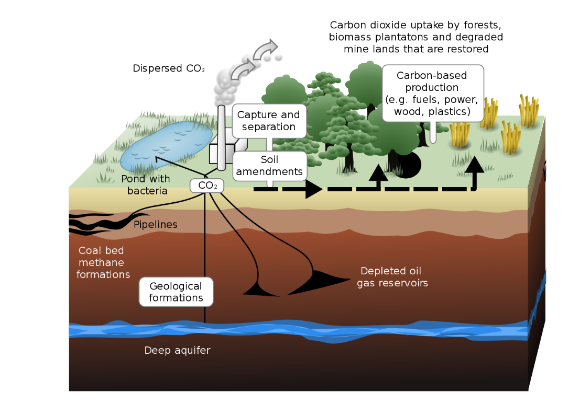
Understanding Diel Vertical Migration (DVM)
- DVM Overview
- Diel Vertical Migration (DVM) refers to the coordinated movement of marine organisms, commonly observed in deep-sea inhabitants such as zooplankton, where they vertically migrate in the water column—ascending towards the surface at night and descending to deeper levels during the day.
- Survival Strategy
- This migration pattern serves as a strategic survival tactic for these organisms, aiding in locating food resources while minimizing exposure to predators.
- Nocturnal Feeding Strategy
- During dusk, organisms residing in the mesopelagic layer, also known as the Deeper Layer or Twilight Zone, ascend to the safety of the epipelagic zone or Upper Layer.
- This nocturnal movement allows them to capitalize on the cover of darkness, facilitating the consumption of microscopic phytoplankton while evading diurnal predators.
- Planet's Largest Biomass Migration
- This finely tuned and synchronized migration, aligned with natural light cycles, holds the distinction of being the planet's largest biomass migration, occurring daily across all oceans.
DVM's Contribution to Carbon Sequestration
- Organisms dwelling in the mesopelagic layer play an active role in extracting significant carbon from upper ocean layers during their feeding on surface plankton, subsequently transporting it to deeper waters.
- Within the twilight zone, migratory animals contribute to the food chain by transferring consumed carbon to their predators.
- The resulting carbon-rich waste descends to the ocean floor, functioning as a vital carbon sink.
- This process traps carbon dioxide and contributes to the regulation of atmospheric carbon concentration.
How DVM Contributes to Carbon Sequestration
- The organisms populating the mesopelagic layer play an integral role in extracting substantial carbon from upper ocean layers as they feed on surface plankton, carrying this carbon to deeper waters.
- Migratory animals within the twilight zone contribute to the food chain by passing on the consumed carbon to their predators.
- The ensuing carbon-rich waste descends to the ocean floor, serving as a critical carbon sink.
- This mechanism effectively traps carbon dioxide, aiding in the regulation of atmospheric carbon concentration.
|
UPSC Previous Year Questions Prelims (2012) Q. The acidification of oceans is increasing. Why is this phenomenon a cause of concern?
Which of the statements given above is/are correct? (a) 1, 2 and 3 only Ans: (a) Prelims (2017) Q. In the context of mitigating the impending global warming due to anthropogenic emissions of carbon dioxide, which of the following can be the potential sites for carbon sequestration?
Select the correct answer using the code given below: (a) 1 and 2 only Ans: (d) Prelims (2012) Q. Consider the following agricultural practices:
which of the above helps/help in carbon sequestration/storage in the soil? (a) 1 and 2 only Ans: (b) |
Source: TH
Second Phase of LeadIT - Edukemy Current Affairs
In News: During COP 28, India and Sweden introduced the three pillars of the second phase of LeadIT (2.0) at the LeadIT Summit 2023 in the UAE, as declared by the Ministry of Environment, Forest and Climate Change.
Understanding the Leadership Group for Industry Transition (LeadIT)
Overview
- LeadIT, a global initiative launched by Sweden and India at the United Nations Climate Action Summit in 2019 and supported by the World Economic Forum, is dedicated to expediting the shift of challenging sectors—steel, cement, chemicals, aviation, and shipping—towards low-carbon pathways.
- Comprising 38 members, including active participant India, LeadIT seeks to align with the Paris Agreement's goals.
Key Features of the Second Phase
- Mission
- In the second phase of LeadIT, the focus is on fostering policies and regulations supporting an inclusive industry transition through public-private partnerships.
- The aim is to mobilize resources, facilitate knowledge-sharing, and accelerate pathways towards achieving net-zero industry emissions by 2050.
- LeadIT Pillars
- Global Forum for a Just and Equitable Industry Transition
- This pillar ensures ongoing dialogue and collaboration between governments and industries.
- It sustains LeadIT's engagement with multilateral groups, such as UN Climate Action and UNFCCC COP presidencies, facilitates knowledge-sharing, and monitors the transition's progress.
- Technology Transfer and Co-development
- Dedicated to facilitating business-to-business technology transfer and enhancing national institutional capacity for innovation.
- Industry Transition Partnerships
- The LeadIT Secretariat supports members in establishing industry transition partnerships, particularly in emerging markets and developing economies.
- These partnerships involve mapping, coordinating, and strengthening international assistance to enhance the effectiveness of low-carbon industrial projects.
- The overarching goal is to create favourable conditions for a pipeline of viable green industrial projects.
- Global Forum for a Just and Equitable Industry Transition
Source: PIB
Wheeler Island - Edukemy Current Affairs
In News: India's top military R&D agency, the Defence Research and Development Organisation (DRDO), will halt missile testing on Wheeler Island off the Odisha coast during the mass nesting season of Olive Ridley Sea turtles, according to reports.
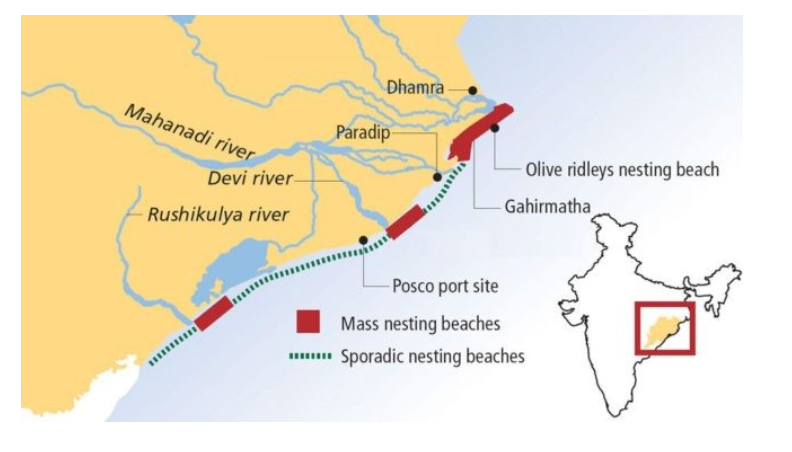
Exploring Abdul Kalam Island (Wheeler Island)
- Overview
- Abdul Kalam Island, previously known as Wheeler Island, is situated off the coast of Odisha and was renamed in honour of the late President Dr. APJ Abdul Kalam.
- This transformation aimed to inspire youth towards a scientific mindset. The island stands as India's sole location with an integrated test range, housing a missile testing facility.
- Significance
- The integrated test range on Abdul Kalam Island serves as the testing ground for various indigenous missiles, including the Akash, Agni, and Prithvi missiles.
- This facility plays a crucial role in advancing India's missile technology.
- Geographical Details
- Covering an expanse of 390 acres, the island spans 2 km in length.
- Situated in the Bay of Bengal, it is characterized by a soil formation without rocks, making it a distinctive location for missile testing.
Source: TOI
Pinna nobilis Pinna nobilis - Edukemy Current Affairs
In News: Marine biologists have recently reported a significant resurgence in the population of a large clam, once on the brink of extinction, in the waters off Croatia.

Understanding Pinna nobilis: A Critically Endangered Marine Clam
- Overview
- Pinna nobilis, commonly known as the noble pen shell, is a large species of Mediterranean clam belonging to the marine bivalve mollusc family Pinnidae.
- Recognized for its remarkable size, with shells growing up to 1.2 meters across, these clams play a crucial ecological role by filtering seawater, fostering the flourishing of other organisms.
- Distinctive Features
- These clams anchor themselves to rocks using a robust byssus made up of silk-like threads, historically used for cloth production.
- The secretion of these fibres, composed of keratin and proteins, can reach lengths of up to 6 cm.
- The inner surface of the shell boasts a striking mother-of-pearl lining.
- Pinna nobilis also hosts symbiotic shrimp within its shell, believed to provide warnings to the clam in the face of threats, prompting it to close shut.
- Distribution and Threats
- Endemic to the Mediterranean Sea, Pinna nobilis faces vulnerability to pollution and shell damage due to its relatively fragile nature.
- The species experienced a significant decline starting around 2016 due to a deadly pathogen.
- Conservation Status
- With a critically endangered status according to the International Union for Conservation of Nature (IUCN), Pinna nobilis requires urgent conservation efforts to ensure its survival in the Mediterranean ecosystem.
Source: TH
Pangalokha Wildlife Sanctuary - Edukemy Current Affairs
In News: A Royal Bengal Tiger was recently sighted at an elevation of 3,640 meters in the Pangalokha Wildlife Sanctuary in Sikkim.
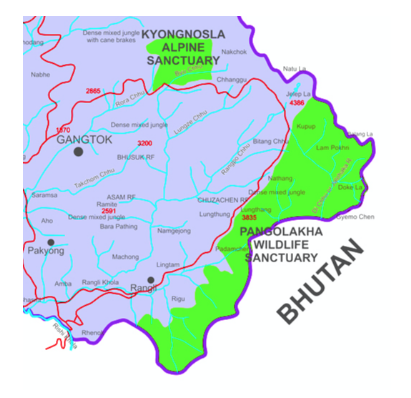
Exploring Pangalokha Wildlife Sanctuary
- Location and Connectivity
- Situated in the East Sikkim district, Pangalokha Wildlife Sanctuary is intricately linked to the forests of Bhutan and Neora Valley National Park in West Bengal.
- The Pangolakha Range, positioned below the Chola Range, acts as a natural divide between Sikkim and Bhutan.
- Vegetation
- Encompassing alpine, temperate, and subtropical vegetation, the sanctuary features high-altitude lakes near JelepLa. Noteworthy flora includes Rhododendron, Silver Fir, Juniper Forest, moss-filled oak forests, and dense bamboo thickets.
- Rich Flora and Fauna
- The sanctuary boasts a diverse array of charismatic species, including red pandas, snow leopards, Himalayan musk deer, Himalayan goral, and Himalayan black bears.
- The habitat is characterized by Rhododendron-covered hills, making it a haven for unique plant and animal life.
- The region is further accentuated by its scenic landscapes and the presence of high-altitude lakes.
Source: DH
Ghaggar River Cleanup: Residents Unite Against Pollution
In News: In an effort to raise awareness about the harmful impact of waste disposal in the Ghaggar River, residents from across the Ghaggar region conducted a cleanliness drive at the Chatt Puja Ghat of the river recently.
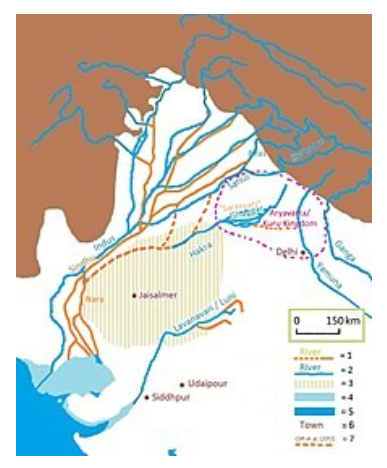
Exploring the Ghaggar River
- Characteristics
- The Ghaggar River is a seasonal watercourse, flowing intermittently and predominantly during the monsoon season.
- Course
- Originating from the Shivalik Range in northwestern Himachal Pradesh, the river courses approximately 200 miles (320 km) southwest through Haryana, where it merges with the Saraswati River.
- Its journey concludes as it dries up in the Thar Desert of Rajasthan.
- Notably, the Ghaggar River contributes to two irrigation canals extending into Rajasthan.
- In Pakistan, the river is known as the Hakra, forming the Ghaggar-Hakra River.
- Historical Significance
- The Ghaggar River holds historical importance, with many historians associating it with the Vedic Saraswati River.
- The banks of the Ghaggar have revealed numerous settlements from the Indus Valley Civilization, suggesting a connection to the ingenious Vedic Aryans.
- It is speculated that the riverbed once received the waters of the Sutlej and Yamuna.
- Tributaries
- Key tributaries of the Ghaggar include the Kaushalya River, Markanda, Sarsuti, Tangri, and Chautang.
Source: TOI
Budgett’s frog- Edukemy Current Affairs
In News: Researchers at the Indian Institute of Science's molecular biophysics unit found that peptides from Budgett's frog can combat enzymes in disease-causing pathogens.
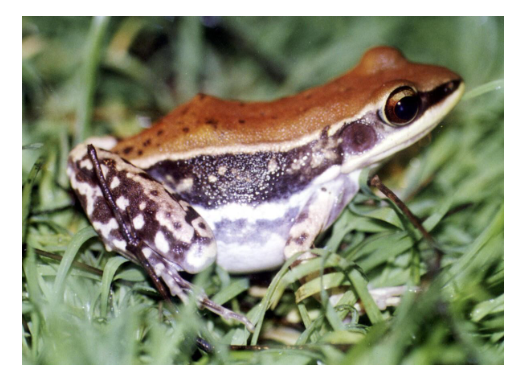
Exploring Budgett’s Frog
- Behaviour
- Budgett’s frogs display high intelligence and aggression, employing defensive tactics such as inflating themselves, standing on short legs, and lunging with an open mouth accompanied by a shrill shriek when threatened.
- During the dry season, they retreat to burrows, shedding skin layers to create a waterproof cocoon for moisture retention.
- They leverage exceptional night vision and movement sensitivity for hunting.
- Habitat/Range
- These frogs inhabit or near permanent or seasonal bodies of water in Paraguay, Argentina, and Bolivia.
- Conservation Status
- Listed as "Least Concern" on the IUCN Red List, Budgett’s frogs currently face no imminent conservation threats.
Source: TH
Challenges Confronting India in the South Asian Region
In News: The article explores the challenges and opportunities encountered by India in its neighbouring regions, particularly in light of evolving regional and global dynamics.
India's Conundrums in the Present Geopolitical Landscape
India encounters various challenges in its neighbouring regions, presenting distinct dilemmas that can be classified into three primary types:
- Political Challenges:
- Emergence of Anti-India Regimes:
- A significant dilemma revolves around the ascent of politically anti-India regimes in South Asia.
- Notably, the Maldives' new government has explicitly expressed an anti-India stance, requesting the withdrawal of Indian troops.
- Potential Ideological Shifts:
- The impending elections in Bangladesh, potentially leading to a Khaleda Zia-led government, introduce an additional layer to India's political challenges.
- The concern is that such a government might adopt an ideology that is unfavourable to India, complicating diplomatic ties and regional stability.
- Emergence of Anti-India Regimes:
- Structural Predicaments:
- Rising Chinese Influence:
- India grapples with structural dilemmas due to China's increasing influence in South Asia.
- The growing presence of China poses a challenge to India's regional dominance and influence, attracting nations seeking tangible benefits.
- This structural shift makes it challenging for India to effectively compete in meeting the material needs of its neighbours, potentially causing them to lean towards China.
- Rising Chinese Influence:
- Normative Quandaries:
- Changing Regional Dynamics:
- Traditionally, India has approached the region with normative and political considerations.
- However, the emergence of China as a non-normative alternative challenges India's conventional calculus.
- China's 'norms-free-zone' approach disrupts the dynamics of South Asian diplomacy, as states in the region may find it appealing to align with a power that does not impose normative conditions.
- Limited Alternatives:
- The absence of viable alternatives for South Asian states creates a dilemma. With China offering a non-normative alternative, India faces the challenge of adjusting its approach to accommodate the evolving dynamics in the region.
- This shift poses a challenge to India's historical dominance in setting norms and political expectations in its neighbourhood.
- Changing Regional Dynamics:
China's Distinctive Advantages Over India in Regional Dynamics
- Belt and Road Initiative (BRI) and Economic Influence
- China's active involvement in the Belt and Road Initiative (BRI) and other economic projects has led to increased connectivity and trade with smaller states in the region.
- The financial strength and commitment displayed by China in these initiatives give it a notable edge over India, as its deeper pockets enable a more substantial impact.
- Outreach to South Asian States
- China exhibits a proactive approach in reaching out to South Asian states, including those facing diplomatic challenges or crises.
- Notable examples include engagement with Taliban-led Afghanistan, military-ruled Myanmar, and crisis-hit Sri Lanka, contributing to a more significant overall impact compared to India.
- Border Dispute Resolution Strategy
- China's strategy of actively resolving border disputes with its neighbours, excluding India, serves to position itself as a reliable and cooperative partner in the region.
- While India also engages in efforts to resolve border issues, the focused approach and specific strategies employed by China contribute to its distinctive standing in regional geopolitics.
India's Dilemmas: Causes and Context
- Diminishing Presence of the United States
- The changing regional geopolitical landscape is marked by the reduced influence of the United States in South Asia.
- While the U.S. presence was not always beneficial for India, its absence has created a power vacuum, allowing China to step in and fill the void.
- Rise of China as a Geopolitical Buffer
- China's substantial rise as a major geopolitical player serves as a "geopolitical buffer" for smaller states in the region.
- The departure of the United States has prompted these states to strategically align themselves with China, utilizing the "China card" in foreign policy.
- Neighbours' Strategic Autonomy and China's Appeal
- Neighbouring states, desiring strategic autonomy, show a preference for asserting independence in their relationships, especially with India.
- However, when dealing with China, these states tend to leverage their relationships with both India and China, reflecting the challenge India faces in maintaining influence amid the strategic choices made by its neighbours.
Recommendations for India
- Engage Friendly External Actors
- Strengthen bilateral and multilateral ties with neighbours based on mutual respect, trust, and cooperation.
- Emphasize historical, cultural, and economic links, offering assistance in trade, connectivity, development, security, and disaster management.
- Strive to be a reliable and constructive partner rather than a domineering power.
- Flexible Diplomacy
- Adapt diplomacy to involve various stakeholders in neighbouring countries.
- Focus on reducing hostility instead of harbouring hatred towards anti-India elements.
- Engage with current leaders while remaining open to broader diplomatic outreach.
- Expand Diplomatic Personnel
- Invest in additional resources and personnel for diplomatic pursuits.
- Increase the number and quality of diplomats to represent India effectively.
- Enhance public diplomacy and cultural outreach to showcase achievements, diversity, and soft power, fostering people-to-people exchanges.
Source: TH
Share the article
Edukemy’s Current Affairs Quiz is published with multiple choice questions for UPSC exams
MCQ
Get Latest Updates on Offers, Event dates, and free Mentorship sessions.

Get in touch with our Expert Academic Counsellors 👋
FAQs
UPSC Daily Current Affairs focuses on learning current events on a daily basis. An aspirant needs to study regular and updated information about current events, news, and relevant topics that are important for UPSC aspirants. It covers national and international affairs, government policies, socio-economic issues, science and technology advancements, and more.
UPSC Daily Current Affairs provides aspirants with a concise and comprehensive overview of the latest happenings and developments across various fields. It helps aspirants stay updated with current affairs and provides them with valuable insights and analysis, which are essential for answering questions in the UPSC examinations. It enhances their knowledge, analytical skills, and ability to connect current affairs with the UPSC syllabus.
UPSC Daily Current Affairs covers a wide range of topics, including politics, economics, science and technology, environment, social issues, governance, international relations, and more. It offers news summaries, in-depth analyses, editorials, opinion pieces, and relevant study materials. It also provides practice questions and quizzes to help aspirants test their understanding of current affairs.
Edukemy's UPSC Daily Current Affairs can be accessed through:
- UPSC Daily Current Affairs can be accessed through Current Affairs tab at the top of the Main Page of Edukemy.
- Edukemy Mobile app: The Daily Current Affairs can also be access through Edukemy Mobile App.
- Social media: Follow Edukemy’s official social media accounts or pages that provide UPSC Daily Current Affairs updates, including Facebook, Twitter, or Telegram channels.



